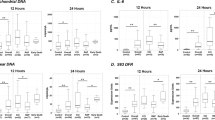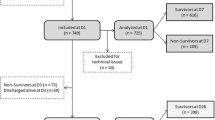Abstract
Purpose
Overactive neutrophils are thought to be key drivers in the development of post-traumatic multiple organ dysfunction syndrome (MODS). Little is known about the role of inflammation-related lnc-IL7R in trauma. Thus, we aimed to explore the association between neutrophil-derived lnc-IL7R and post-traumatic MODS.
Methods
Total RNA was extracted from the isolated circulating neutrophils in 60 patients with trauma and 33 healthy volunteers for lnc-IL7R expression determination by real-time PCR. The correlation of lnc-IL7R expression with disease severity and the development of post-traumatic MODS was analyzed.
Results
The lnc-IL7R levels were significantly lower in trauma patients, especially in those with severe trauma [Injury Severity Score (ISS) ≥ 16], and correlated negatively with the ISS, Acute Physiology and Chronic Health Evaluation II score, and length of ICU stay. The lnc-IL7R levels were also significantly decreased in patients who developed MODS than in those who did not. Lnc-IL7R was an independent predictor of MODS [odds ratio (OR) 0.654, (0.435–0.982), p = 0.041]. The area under the curve for predicting post-traumatic MODS was 0.799 (sensitivity 76.9%, specificity 71.4%), with a cutoff value of 0.024.
Conclusions
Neutrophil-derived lnc-IL7R is an independent predictor of post-traumatic MODS; therefore, it could be a useful predictive marker for MODS.



Similar content being viewed by others
References
Trunkey DD. Trauma. Accidental and intentional injuries account for more years of life lost in the U.S. than cancer and heart disease. Among the prescribed remedies are improved preventive efforts, speedier surgery and further research. Sci Am. 1983;249(2):28–35.
Reed D, Kemmerly SA. Infection control and prevention: a review of hospital-acquired infections and the economic implications. Ochsner J. 2009;9(1):27–31.
Bochicchio GV, Joshi M, Knorr KM, Scalea TM. Impact of nosocomial infections in trauma: does age make a difference? J Trauma. 2001;50(4):612–7 (discussion 7–9).
Wang KC, Chang HY. Molecular mechanisms of long noncoding RNAs. Mol Cell. 2011;43(6):904–14. https://doi.org/10.1016/j.molcel.2011.08.018.
Clark MB, Mattick JS. Long noncoding RNAs in cell biology. Semin Cell Dev Biol. 2011;22(4):366–76. https://doi.org/10.1016/j.semcdb.2011.01.001.
Li J, Tian H, Yang J, Gong Z. Long noncoding RNAs regulate cell growth, proliferation, and apoptosis. DNA Cell Biol. 2016;35(9):459–70. https://doi.org/10.1089/dna.2015.3187.
Shi X, Sun M, Liu H, Yao Y, Song Y. Long non-coding RNAs: a new frontier in the study of human diseases. Cancer Lett. 2013;339(2):159–66. https://doi.org/10.1016/j.canlet.2013.06.013.
Lorenzen JM, Schauerte C, Kielstein JT, Hubner A, Martino F, Fiedler J, et al. Circulating long noncoding RNATapSaki is a predictor of mortality in critically ill patients with acute kidney injury. Clin Chem. 2015;61(1):191–201. https://doi.org/10.1373/clinchem.2014.230359.
Wan B, Xu WJ, Xu WN, Zhan P, Wu GN, Jin JJ, et al. Plasma long noncoding RNA IL-7R as a prognostic biomarker for clinical outcomes in patients with acute respiratory distress syndrome. Clin Respir J. 2018;12(4):1607–14. https://doi.org/10.1111/crj.12717.
Edgington-Mitchell LE. Long noncoding RNAs: novel links to inflammatory bowel disease? Am J Physiol Gastrointest Liver Physiol. 2016;311(3):G444–G445. https://doi.org/10.1152/ajpgi.00271.2016.
Yang LX, Yang LK, Zhu J, Chen JH, Wang YH, Xiong K. Expression signatures of long non-coding RNA and mRNA in human traumatic brain injury. Neural Regen Res. 2019;14(4):632–41. https://doi.org/10.4103/1673-5374.247467.
Nathan C. Neutrophils and immunity: challenges and opportunities. Nat Rev Immunol. 2006;6(3):173–82. https://doi.org/10.1038/nri1785.
Tsukamoto T, Chanthaphavong RS, Pape HC. Current theories on the pathophysiology of multiple organ failure after trauma. Injury. 2010;41(1):21–6. https://doi.org/10.1016/j.injury.2009.07.010.
Abraham E. Neutrophils and acute lung injury. Crit Care Med. 2003;31(4 Suppl):S195–S199199. https://doi.org/10.1097/01.ccm.0000057843.47705.e8.
Segel GB, Halterman MW, Lichtman MA. The paradox of the neutrophil's role in tissue injury. J Leukoc Biol. 2011;89(3):359–72. https://doi.org/10.1189/jlb.0910538.
Botha AJ, Moore FA, Moore EE, Sauaia A, Banerjee A, Peterson VM. Early neutrophil sequestration after injury: a pathogenic mechanism for multiple organ failure. J Trauma. 1995;39(3):411–7.
Donnelly SC, MacGregor I, Zamani A, Gordon MW, Robertson CE, Steedman DJ, et al. Plasma elastase levels and the development of the adult respiratory distress syndrome. Am J Respir Crit Care Med. 1995;151(5):1428–33. https://doi.org/10.1164/ajrccm.151.5.7735596.
Hietbrink F, Oudijk EJ, Braams R, Koenderman L, Leenen L. Aberrant regulation of polymorphonuclear phagocyte responsiveness in multitrauma patients. Shock. 2006;26(6):558–64. https://doi.org/10.1097/01.shk.0000233196.40989.78.
Shih HC, Su CH, Lee CH. Alternations of surface antigens on leukocytes after severe injury: correlation with infectious complications. Intensive Care Med. 1998;24(2):152–6. https://doi.org/10.1007/s001340050537.
Margraf S, Logters T, Reipen J, Altrichter J, Scholz M, Windolf J. Neutrophil-derived circulating free DNA (cf-DNA/NETs): a potential prognostic marker for posttraumatic development of inflammatory second hit and sepsis. Shock. 2008;30(4):352–8. https://doi.org/10.1097/SHK.0b013e31816a6bb1.
Paunel-Gorgulu A, Kirichevska T, Logters T, Windolf J, Flohe S. Molecular mechanisms underlying delayed apoptosis in neutrophils from multiple trauma patients with and without sepsis. Mol Med. 2012;18:325–35. https://doi.org/10.2119/molmed.2011.00380.
Hesselink L, Heeres M, Paraschiakos F, Ten Berg M, Huisman A, Hoefer IE, et al. A rise in neutrophil cell size precedes organ dysfunction after trauma. Shock. 2019;51(4):439–46. https://doi.org/10.1097/shk.0000000000001200.
Kong T, Park YS, Lee HS. The delta neutrophil index predicts development of multiple organ dysfunction syndrome and 30-day mortality in trauma patients admitted to an intensive care unit: a retrospective analysis. Sci Rep. 2018;8(1):17515. https://doi.org/10.1038/s41598-018-35796-4.
Yang J, Liang Y, Han H, Qin H. Identification of a miRNA signature in neutrophils after traumatic injury. Acta Biochim Biophys Sin. 2013;45(11):938–45. https://doi.org/10.1093/abbs/gmt100.
Yang J, Han H, Zhao Y, Qin H. Specific miRNA and its target in neutrophils after traumatic injury. Acta Biochim Biophys Sin. 2015;47(9):749–54. https://doi.org/10.1093/abbs/gmv072.
Knaus WA, Draper EA, Wagner DP, Zimmerman JE. APACHE II: a severity of disease classification system. Crit Care Med. 1985;13(10):818–29.
Greenspan L, McLellan BA, Greig H. Abbreviated injury scale and injury severity score: a scoring chart. J Trauma. 1985;25(1):60–4.
Hazeldine J, Naumann DN. Prehospital immune responses and development of multiple organ dysfunction syndrome following traumatic injury: a prospective cohort study. PLoS Med. 2017;14(7):e1002338. https://doi.org/10.1371/journal.pmed.1002338.
Hjorth R, Jonsson AK, Vretblad P. A rapid method for purification of human granulocytes using percoll. A comparison with dextran sedimentation. J Immunol Methods. 1981;43(1):95–101. https://doi.org/10.1016/0022-1759(81)90040-5.
Schmittgen TD, Livak KJ. Analyzing real-time PCR data by the comparative C(T) method. Nat Protoc. 2008;3(6):1101–8. https://doi.org/10.1038/nprot.2008.73.
Manson J, Cole E, De'Ath HD, Vulliamy P, Meier U, Pennington D, et al. Early changes within the lymphocyte population are associated with the development of multiple organ dysfunction syndrome in trauma patients. Crit Care. 2016;20(1):176. https://doi.org/10.1186/s13054-016-1341-2.
Shepherd JM, Cole E, Brohi K. Contemporary patterns of multiple organ dysfunction in trauma. Shock. 2017;47(4):429–35. https://doi.org/10.1097/shk.0000000000000779.
Kleinveld DJ, Tuip-de Boer AM, Hollmann MW, Juffermans NP. Early increase in anti-inflammatory biomarkers is associated with the development of multiple organ dysfunction syndrome in severely injured trauma patients. Trauma Surg Acute Care Open. 2019;4(1):e000343. https://doi.org/10.1136/tsaco-2019-000343.
Haasper C, Kalmbach M, Dikos GD, Meller R, Muller C, Krettek C, et al. Prognostic value of procalcitonin (PCT) and/or interleukin-6 (IL-6) plasma levels after multiple trauma for the development of multi organ dysfunction syndrome (MODS) or sepsis. Technol Health Care. 2010;18(2):89–100. https://doi.org/10.3233/thc-2010-0571.
Cole E, Gillespie S, Vulliamy P, Brohi K. Multiple organ dysfunction after trauma. Br J Surg. 2020;107(4):402–12. https://doi.org/10.1002/bjs.11361.
Fredriksson MI. Effect of priming in subpopulations of peripheral neutrophils from patients with chronic periodontitis. J Periodontol. 2012;83(9):1192–9. https://doi.org/10.1902/jop.2012.110584.
Tregay N, Begg M, Cahn A, Farahi N, Povey K, Madhavan S, et al. Use of autologous (99m)technetium-labelled neutrophils to quantify lung neutrophil clearance in COPD. Thorax. 2019;74(7):659–66. https://doi.org/10.1136/thoraxjnl-2018-212509.
Mendez-Ferrer S, Michurina TV, Ferraro F, Mazloom AR, Macarthur BD, Lira SA, et al. Mesenchymal and haematopoietic stem cells form a unique bone marrow niche. Nature. 2010;466(7308):829–34. https://doi.org/10.1038/nature09262.
Pember SO, Barnes KC, Brandt SJ, Kinkade JM Jr. Density heterogeneity of neutrophilic polymorphonuclear leukocytes: gradient fractionation and relationship to chemotactic stimulation. Blood. 1983;61(6):1105–15.
Rizoli SB, Rhind SG, Shek PN, Inaba K, Filips D, Tien H, et al. The immunomodulatory effects of hypertonic saline resuscitation in patients sustaining traumatic hemorrhagic shock: a randomized, controlled, double-blinded trial. Ann Surg. 2006;243(1):47–57. https://doi.org/10.1097/01.sla.0000193608.93127.b1.
Venaille TJ, Misso NL, Phillips MJ, Robinson BW, Thompson PJ. Effects of different density gradient separation techniques on neutrophil function. Scand J Clin Lab Investig. 1994;54(5):385–91. https://doi.org/10.3109/00365519409088438.
Sroka J, Kordecka A, Wlosiak P, Madeja Z, Korohoda W. Separation methods for isolation of human polymorphonuclear leukocytes affect their motile activity. Eur J Cell Biol. 2009;88(9):531–9. https://doi.org/10.1016/j.ejcb.2009.05.005.
Dossett LA, Redhage LA, Sawyer RG, May AK. Revisiting the validity of APACHE II in the trauma ICU: improved risk stratification in critically injured adults. Injury. 2009;40(9):993–8. https://doi.org/10.1016/j.injury.2009.03.004.
Gu X, Yao Y, Wu G, Lv T, Luo L, Song Y. The plasma mitochondrial DNA is an independent predictor for post-traumatic systemic inflammatory response syndrome. PLoS ONE. 2013;8(8):e72834. https://doi.org/10.1371/journal.pone.0072834.
Cui H, Xie N, Tan Z, Banerjee S, Thannickal VJ, Abraham E, et al. The human long noncoding RNA lnc-IL7R regulates the inflammatory response. Eur J Immunol. 2014;44(7):2085–95. https://doi.org/10.1002/eji.201344126.
Hazeldine J, Hampson P, Lord JM. The impact of trauma on neutrophil function. Injury. 2014;45(12):1824–33. https://doi.org/10.1016/j.injury.2014.06.021.
Roderburg C, Luedde M, Vargas Cardenas D, Vucur M, Scholten D, Frey N, et al. Circulating microRNA-150 serum levels predict survival in patients with critical illness and sepsis. PLoS ONE. 2013;8(1):e54612. https://doi.org/10.1371/journal.pone.0054612.
Cuschieri J, Bulger E, Schaeffer V, Sakr S, Nathens AB, Hennessy L, et al. Early elevation in random plasma IL-6 after severe injury is associated with development of organ failure. Shock. 2010;34(4):346–51. https://doi.org/10.1097/SHK.0b013e3181d8e687.
Acknowledgements
The authors wish to thank the staff in the emergency department at Jinling Hospital for the great work.
Funding
This work was supported by grants from the National Natural Science Foundation of China (Grant Nos. 81370172, 81570078, 81770082), Jiangsu Provincial Key Research and Development Program (Grant No. BE 2016721), and Natural science Foundation of Jiangsu Province (Grant No. BK20191351). The authors declare no conflicts of interest.
Author information
Authors and Affiliations
Corresponding authors
Ethics declarations
Conflict of interest
The authors declare no conflict of interest.
Rights and permissions
About this article
Cite this article
Jin, J., Qian, H., Wu, G. et al. Neutrophil-derived long noncoding RNA IL-7R predicts development of multiple organ dysfunction syndrome in patients with trauma. Eur J Trauma Emerg Surg 48, 1545–1553 (2022). https://doi.org/10.1007/s00068-020-01403-3
Received:
Accepted:
Published:
Issue Date:
DOI: https://doi.org/10.1007/s00068-020-01403-3




